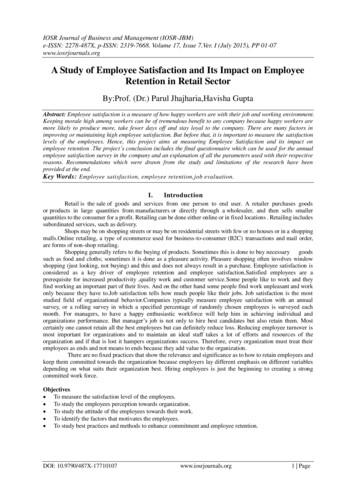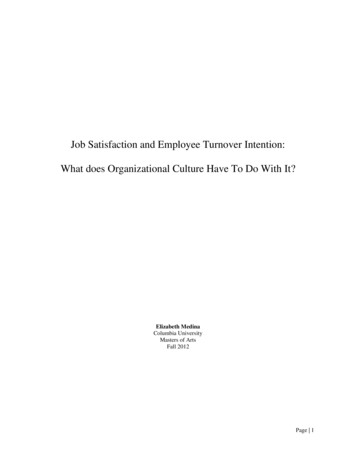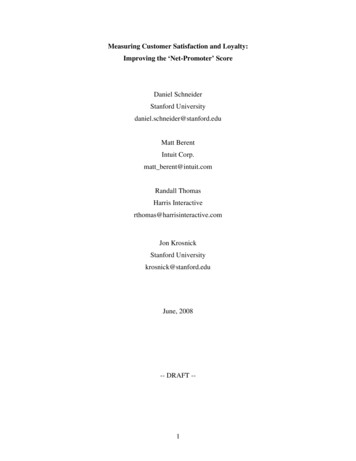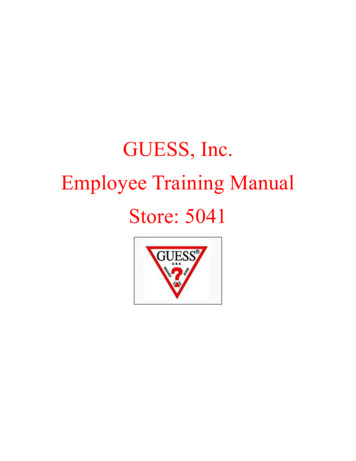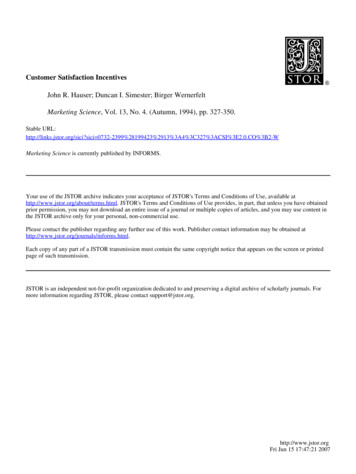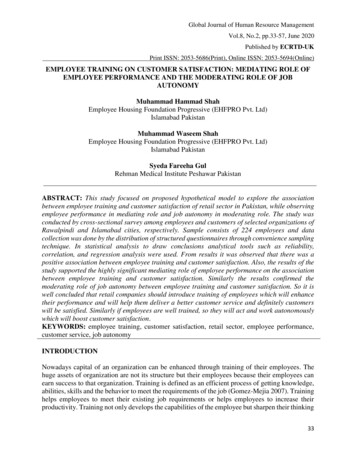
Transcription
Global Journal of Human Resource ManagementVol.8, No.2, pp.33-57, June 2020Published by ECRTD-UKPrint ISSN: 2053-5686(Print), Online ISSN: 2053-5694(Online)EMPLOYEE TRAINING ON CUSTOMER SATISFACTION: MEDIATING ROLE OFEMPLOYEE PERFORMANCE AND THE MODERATING ROLE OF JOBAUTONOMYMuhammad Hammad ShahEmployee Housing Foundation Progressive (EHFPRO Pvt. Ltd)Islamabad PakistanMuhammad Waseem ShahEmployee Housing Foundation Progressive (EHFPRO Pvt. Ltd)Islamabad PakistanSyeda Fareeha GulRehman Medical Institute Peshawar PakistanABSTRACT: This study focused on proposed hypothetical model to explore the associationbetween employee training and customer satisfaction of retail sector in Pakistan, while observingemployee performance in mediating role and job autonomy in moderating role. The study wasconducted by cross-sectional survey among employees and customers of selected organizations ofRawalpindi and Islamabad cities, respectively. Sample consists of 224 employees and datacollection was done by the distribution of structured questionnaires through convenience samplingtechnique. In statistical analysis to draw conclusions analytical tools such as reliability,correlation, and regression analysis were used. From results it was observed that there was apositive association between employee training and customer satisfaction. Also, the results of thestudy supported the highly significant mediating role of employee performance on the associationbetween employee training and customer satisfaction. Similarly the results confirmed themoderating role of job autonomy between employee training and customer satisfaction. So it iswell concluded that retail companies should introduce training of employees which will enhancetheir performance and will help them deliver a better customer service and definitely customerswill be satisfied. Similarly if employees are well trained, so they will act and work autonomouslywhich will boost customer satisfaction.KEYWORDS: employee training, customer satisfaction, retail sector, employee performance,customer service, job autonomyINTRODUCTIONNowadays capital of an organization can be enhanced through training of their employees. Thehuge assets of organization are not its structure but their employees because their employees canearn success to that organization. Training is defined as an efficient process of getting knowledge,abilities, skills and the behavior to meet the requirements of the job (Gomez-Mejia 2007). Traininghelps employees to meet their existing job requirements or helps employees to increase theirproductivity. Training not only develops the capabilities of the employee but sharpen their thinking33
Global Journal of Human Resource ManagementVol.8, No.2, pp.33-57, June 2020Published by ECRTD-UKPrint ISSN: 2053-5686(Print), Online ISSN: 2053-5694(Online)ability and creativity in order to take better decision in time and in a more productive manner(David, 2006). Moreover it also enables employees to deal with the customer in an effectivemanner and respond to their complaints in timely manner (Hollenbeck, Derue and Guzzo, 2004).According to Rowden and Conine (2005), trained employees are more able to satisfy thecustomers. It is an organizational challenge to integrate training and development in humanresource planning and use training to increase employee’s skills and motivation to work towardsa common business goal as opposed to considering training as an isolated activity (Macky &Johnson, 2000). Training is about changing the behavior of the trainee and measuring of trainingbenefits have to start with a consideration of the behavioral change that may or may not haveoccurred. Therefore the goal of training is for its employees to master the knowledge, skill andbehaviors emphasized in training programs and to apply them to their day to day activities(Lashley, 2002). Consumers are demanding more from retailers and are making decisions on whereto shop based on their expectations of merchandise quality and customer service. For a retailer tobe successful they have to offer excellent customer service while ensuring a competitive pricingof their goods. Today consumers have more choices than ever before and if they do not find whatthey want at an acceptable and in a friendly environment they will shop elsewhere (Zachman andFolker 2009).Satisfaction is identified in a variety of senses which depends on what were the customer needsbefore the service, it narrows down from feelings of fulfillment, pleasure, happiness, enjoymentand relief (Zoe, 2006). Customer evaluates the service from the quality of service they are servedwith (Lam and Borton 2006). According to Zeithamal et al. (2006) the customer satisfaction iswhen the service the customers are being served with, matches the customer expectation.If customers are satisfied and are well served then the success will be for the business. Customersatisfaction can be achieved through its employees. The employees who are dealing withcustomers shall be well trained. If employees are well trained their performance will ameliorateand definitely customers will be satisfied. Improved capabilities, knowledge and skills of thetalented workforce are among some of the main sources of competitive advantage in a globalmarket (McKinsey, 2006). To develop the desired knowledge, skills and abilities of the employees,to perform well on the job, requires effective training programs which definitely effect employeemotivation and commitment (Meyer and Allen, 1991). Nowadays organizations apply long termplanning and invest in building new skills for their workers, which helps them to cope with theuncertain conditions that they may face in future, thus, improves the performance of employeesthrough superior level of motivation and commitment. When employees recognize theirorganization interest in them through offering training programs, they in turn apply their bestefforts to achieve organizational goals, and show high performance on job. Training is a necessityin the workplace (Ingersoll, 2005). Without training, employees don't have a command on theirresponsibilities or duties (Warner, 2005). Employee training refers to programs that provideworkers with information, new skills, or professional development opportunitiesTraining develops efficiency and results in superior performance on job (Svenja, 2007), byreplacing the traditional weak practices by efficient and effective job related practices (Kathiravan,Devadason and Zakkeer, 2006). Training refers to a planned intervention which aims to improve34
Global Journal of Human Resource ManagementVol.8, No.2, pp.33-57, June 2020Published by ECRTD-UKPrint ISSN: 2053-5686(Print), Online ISSN: 2053-5694(Online)the elements of employee job performance (Chiaburu and Tekleab, 2005). It is all about improvingthe competency and expertise that seems to be necessary for the achievement of organizationalgoals and objectives. Training programs may also help the employees to lessen their anxiety orfrustration, which are originated by the work on job (Chen et al., 2004).Training is determined as the process of enabling employee to complete the task with greaterefficiency and is a vital element of managing the human resource performance strategically(Lawler, 1993; Delaney and Huselid, 1996). If employees are given training programs on theirroles, so their performance will enhance and the customers will be satisfied. The customers willthen stick to that organization and profit will be for the organization. Employee performance,achieved through training, refers to immediate improvements in the knowledge, skills and abilitiesto carry out job related work, and hence achieve more employee commitment towards theorganizational goals (Huselid, 1995; Ichniowski et al., 1997). Kamoche and Mueller (1998)mentioned that training leads to increase in learning capabilities and enhances employeeperformance and ultimately higher return on investment (in training) for the firm. According toWright and Geroy (2001), employee skills and behaviors change through effective trainingprograms. It not only improves the overall performance of individuals but also improves theknowledge, skills of the workers which are necessary for the future job. Through training theemployee competencies are developed which enables them to implement the job related workefficiently, and achieve objectives of organizations in a timely and in competitive manner.Job autonomy refers to the way of acting independent while performing on job (Baard & Deci,2004). Job autonomy means the freedom and independence with which the employees work in hisorganization (Hackman and Oldham, 1976).The employees work independently when they knowhow to deal with customers, how to fulfill their needs in a timely manner and how to satisfy them.So what if customer needs are not fulfilled in a timely manner? The result may be that the businesswill lost its name in the market and the business cannot compete with its rivalries and ultimatelywill fail. The need for autonomy is marked as one of the principal needs which helps employee toperform well on their jobs (Sheldon, Elliot, Kim, & Kasser, 2001).If employees are well trainedthey will develop skills like how to deal with customers, how to satisfy their needs in timelymanner and satisfy them and their work autonomy will enhance and definitely the customers willbe satisfied. Employees who have high job autonomy feel responsibility for their work outcomessince their personal initiative and perception on how to do the job can effect work outcomes in adirect manner (Bandura, 1999; Hackman and Oldham, 1976). Thus the employees with high jobautonomy will fulfill the needs of customers accurately and in a timely manner because theemployee will know everything about the job environment and products they are selling. Forexample: If the employees are well trained and they are given all sorts of information regardingevery product they are selling and if a customer needs some specific information regarding aproduct. So employee without asking anyone can give the customer information and can satisfyhis needs in a remarkable and timely manner. Employees with low job autonomy have lessfreedom, discretion and less power to attain customer satisfaction (Parker & Wall, 2001).35
Global Journal of Human Resource ManagementVol.8, No.2, pp.33-57, June 2020Published by ECRTD-UKPrint ISSN: 2053-5686(Print), Online ISSN: 2053-5694(Online)Problem StatementThis study focuses on retail sector in Pakistan as in many multinational companies it is a bigproblem that whenever they hire new employees they could not satisfy the customers andultimately their productivity is low. The reason for this problem is that employees are not trainedon their job positions due to which their performance is low and customers are not satisfied fromthe way they serve them. Although the business main goal is to retain its customers and to servethem in an efficient and timely manner, but this cannot be achieved without training of itsemployees. Similarly the second main problem in retail sector is that employees are not welltrained due to which they cannot work with freedom to deal with customers and fulfill their needsand achieve the business objectives. The pros of this study will be that customer satisfaction willenhance by giving the employees training as this training will help to enhance job autonomy ofemployees due to which employee will act independently. Similarly this study will help to enhanceperformance of employees by giving them training which will ultimately result in enhancedcustomer satisfaction. If this study is not done the cons will be that employees of targeted industrywill still face such problem which will result in dissatisfaction of customers and ultimatelybusiness will result in failure.Research Objectives:The objectives of the study are as follows: To understand the importance of training in retail sector To discover the aggregate work of employee training, job autonomy, employeeperformance and customer satisfaction in retail sectors of Pakistan To analyze the impact of employee training on customer satisfaction To analyze the impact of employee performance on customer satisfaction To find out the mediating role of employee performance between employee training andcustomer satisfaction. To find out the moderating role of Job autonomy between employee training and customersatisfactionResearch Questions: What is the impact of employee training on customer satisfaction? What is the impact of employee training on employee performance? What is the impact of employee performance on customer satisfaction? Does employee performance mediate between employee training and customersatisfaction? Does job autonomy moderates between employee training and customer satisfaction?Research Significance:Nowadays the productivity and profit depends upon the customers. In-fact the business main goalis to retain its customers and to achieve their satisfaction. But retaining the customers and toachieve their satisfaction is a challenge in retail sector. Hence this study will cover as how to satisfythe customer and to achieve business goals and objectives. The significance of this study wouldbe that it would greatly ameliorate the productivity for the organizations. Training of employees36
Global Journal of Human Resource ManagementVol.8, No.2, pp.33-57, June 2020Published by ECRTD-UKPrint ISSN: 2053-5686(Print), Online ISSN: 2053-5694(Online)would result in an outclass performance of employees which ultimately will result in customersatisfaction and will enhance the revenue of organizations. Secondly this study will help out themanagers and owners of the organizations to better understand the importance of training and toinitiate the training programs in their organizations so in order to attain the customer satisfaction.LITERATURE REVIEWEmployee Training and Customer Satisfaction:Chaichi (2012) studied the impact of staff training on customer satisfaction in travel agencies inMalaysia. A sample size of 167 customers who travelled with travel agencies was utilized forcarrying out the study. The results showed that if the staff of travel agency will be trained well sothe customers will be satisfied. Some of the employees have lack of skills, abilities, knowledgeand competencies due to this they are failed to accomplish task on timely basis and customers arenot satisfied (Zuhair Abbas 2014). Agarwal (2010) stated that development of skills of employeesand to satisfy the customers are the main purposes of training of employees. Training helpsmanagers to gain knowledge, skills, abilities and competencies which are used to solve challengesexperienced at workplace and at the same time to help employees realize their career goals andaspirations i.e. customer satisfaction (Blanchard, 2004). Training gives learning opportunities andleads to organizational commitment and customer satisfaction (Armstong, 2009). According to astudy by Choo and Bowley (2007) stated that training has a positive impact on productivity whichresults in customer satisfaction and thus enhancing the brand value. Michael and Combs (2008)while conducting their study deduced that training lessens the chance of failure as trainingameliorate performance and enhances satisfaction. Therefore, the main requirement for companiesis to implement practices and activities that can support employees to get better and perform wellin their positions in order to achieve organizational goals (Mathis et al., 2014). Therefore, inresponse to an increasingly competitive marketplace, growing research attention is being devotedto factors that contribute to desired consumer satisfaction (Liao and Chuang 2004). Someresearchers argue that employee training has more positive effect on CS rather than other humanresource practices (Cantarello et al., 2012). Cantarello et al. (2012) carried out his study to findout that which human resource practices are beneficial for the success of organization. The resultsshowed that training is the most important practice of human resource which enhances theemployee skills and abilities and make the customers satisfy by giving them outclass service.Lee (2012) stated that training is seen as an important driver of a customer service and as anextension of a desirable outcome like customer satisfaction. And as the main objective of anyorganization is to achieve the customer satisfaction, many companies have created customerservice training programs, due to which employees abilities and skills are enhanced and serve thecustomers with a best service. Kumari et al. (2013) stated that in current competitive businessenvironment, customer happiness is the main target of organizations. That’s why companies aretrying to give the customers a better service in order to satisfy their consumers. Organizations aretrying to provide excellent services and products in a timely matter in order to be competitive inthe market.37
Global Journal of Human Resource ManagementVol.8, No.2, pp.33-57, June 2020Published by ECRTD-UKPrint ISSN: 2053-5686(Print), Online ISSN: 2053-5694(Online)Employee training makes a huge contribution to customer satisfaction, as high performingworkforce and better qualified, can meet the demands of consumers (Putachote, 2013). Feng et al.(2014) conducted a study on the effects of employee training and empowerment on customersatisfaction. The sample size included 214 Chinese manufacturing companies. By using structuralequation modelling it was deduced that employee training and empowerment has positive impacton employee training. Hence our proposed hypothesis is:H1: Employee training has a positive impact on customer satisfactionEmployee training and Employee Performance:Training has been shown as performance improvement related benefits for the employee as wellas for the organization by effecting performance of employees positively which help in thedevelopment of employee knowledge, skills, ability, competencies and behavior (Appiah 2010;Harrison 2000; Guest 1997). Swart et al. (2005) concluded from his study that training helps toameliorate of skills and performance which is a way of improving employee performance.According to Swart et al., (2005) stated that training helps the employees develop skills andcompetencies in which employees are lacking. Moreover he stated from his study that traininghelps the employees to enhance their performance and achieve the organizational goals andobjectives. According to Wright & Geroy (2001), the employee abilities and competenciesimprove mostly through effective training programs. He deduced that training and performanceare positively correlated such that training not only enhances performance but also changes thebehavior and skills of employees. Training is a function of capacity building in organizationswhich is used to enhance performance of employees and helps to attain objectives of organizations(Tahir, Yousafzai, Jan, & Hashim, 2014). Training is the most important among human resourcemanagement practices which is planned, systematic and its outcomes help out to enhance skillsand knowledge that are important to perform work effectively (Sultana, Irum, Ahmed, &Mehmood, 2012). According to Sultan et al. (2012), employees who are given training on theirjob are said to be perform well in contrast to the employees who are not offered training programs.Pfeffer (1994) from his study stated that well-trained employees have more capability of attainingperformance targets and gaining competitive advantage and uniqueness in the market. Employeeperformance enhanced through training programs which refer to improvements and gain in theknowledge, skills and capabilities in order to carry out the job related duty, and achieves moreemployee commitment towards the organizational goals (Huselid, 1995; Ichniowski et al., 1997).Bartel (1994) deduced from his study that there is a positive relationship between effective trainingprogram and employee productivity, however to make it possible, (Swart et al., 2005), it is theresponsibility of the managers to identify the factors that blocks training program effectivenessand shall take corrective measures to enhance their effect on employee performance. Kamoche andMueller (1998) from their study deduced that training mostly leads to ameliorate the learning andknowledge and enhances employee performance and ultimately returns higher on the investments(in training) for the firm. Guest (1997) stated in his research study that training programs are themost important aspect of human resource management practices that has positive impact on theemployee knowledge, skills and capabilities which ultimately leads to higher performance ofemployees. Farooq. M, & Aslam. M. K (2011) carried out a study to see the impact of training onemployee performance. It was concluded from the study that training and employee performanceare positively correlated (r .233). Similarly the study conducted by Sultana. A, et.al. (2012)38
Global Journal of Human Resource ManagementVol.8, No.2, pp.33-57, June 2020Published by ECRTD-UKPrint ISSN: 2053-5686(Print), Online ISSN: 2053-5694(Online)carried out in in telecom sector of Pakistan stated that employee training and performance arepositively associated with each other. Similarly (R² .501) showed that training is responsible fora variation of 50.1% in performance of employees. Hence our proposed hypothesis is:H2: Employee training has a positive impact on employee performanceEmployee Performance and Customer SatisfactionNowadays the main target of companies is the customers. Customer satisfaction is the mostimportant aspect of business success and profit. Customers satisfaction depends upon employeeperformance i.e. if employees are performing well and they deliver an outclass service so definitelythe customers will be satisfied and will retain to that organization. The capability of employees torespond in a timely manner and to satisfy customer needs is an important aspect of competitivenessand of success for many companies (Gursoy and Swanger, 2007). Employee performance haspositive effect on customer satisfaction in the service industry (Harter, Schmidt & Hayes, 2002).Hays and Hill (1999) concluded from their study that it’s hard to achieve customer satisfaction inservices sector rather than manufacturing which is due to face to face interaction between customerand employee. They stated that employee performance is important aspect of service industrywhich ultimately results in satisfaction of customers.As employees are the one who are in direct contact with customers, so if employee performanceis low so definitely customers will not be satisfied and they will go elsewhere. Employeeperformance was closely related to customer reliability, customer satisfaction, productivity,profitability and consumer loyalty, and was negatively correlated with employee turnover (Harter,Schmidt and Hayes, 2002). Research has shown that service quality is ultimately related tocustomer loyalty and retention and, eventually, to higher profits for the organization (Rust &Zahorik, 1993; Storbacka, Strandvik, & Gronroos, 1994). Research has shown that excellentperformance is positively related to customer loyalty, in the sense that good performance predictscustomer loyalty (Bitner, Booms, & Tetreault, 1990; Kumar, 2002). Rabbanee et al. (2015)conducted a study on the impact of employee performance on customer loyalty and concluded thatemployee performance has a positive impact on customer loyalty. Furthermore, he stated thatloyalty of customers is achieved if customers are satisfied. So if employees perform well socustomers will be satisfied and will become loyal. Schneider and Bowen (1999) from their studystated that customer dissatisfaction and outrage, often results of performance of employees i.e.when employees don’t perform well and don’t satisfy the needs of customer within the time frameso customers feel dissatisfied.Choudry. P (2014) studied the impact of employee performance on satisfaction of employees inlife insurance corporations in India. The results show that customer satisfaction is dependent onemployee performance and employee performance and customer satisfaction are positivelycorrelated (r .681). Hence our proposed hypothesis is:H3: Employee performance has a positive impact on customer satisfactionJob autonomy as moderator:Job autonomy is defined as the degree of freedom and independence with which an employeeworks. Job autonomy refers to the experience of free will, or volition, in an action or task (Ryan39
Global Journal of Human Resource ManagementVol.8, No.2, pp.33-57, June 2020Published by ECRTD-UKPrint ISSN: 2053-5686(Print), Online ISSN: 2053-5694(Online)& Deci, 2000; Deci & Ryan, 1985). Fuller et al. (2010) studied the moderating role of Jobautonomy between Proactive personality and Job performance and concluded that job autonomyplays a moderating role between proactive personality and job performance. Past studies arguedthat autonomy of employee leads to positive behaviors like psychological involvement, selfgovernance, and persistence to organizational goals (Deci and Ryan, 1985; Gagne, 2003). Jafri. H(2018) studied the relation between emotional intelligence and employee creativity and used jobautonomy as moderator. A sample size of 233 employees was selected from two financial sectors.The moderated regression analysis showed that job autonomy strengthened the associationbetween emotional intelligence and creativity. Employee tendency to take decisions by themselvesmakes the employees enthusiastic about the goals and objectives of company (Stewart et al., 2011).Goussinsky. R (2015) studied the moderating role of job autonomy among customer aggression,felt anger and emotional deviance. From the results it was concluded that under conditions ofperiodic exposure to customer aggression, high level of job autonomy was correlated with highfrequent instances of emotional deviance. Similarly correlation between anger and emotionaldeviance was higher for employees reporting high levels of job autonomy.Li. M, Yi-Han, W.L and Zhang (2015) studied autonomy orientation and thriving at work on therelationship between empowering leadership and change-oriented organizational citizenshipbehavior and concluded that autonomy orientation positively moderates the relationship betweenempowering leadership and change-oriented organizational citizenship behavior. Furthermorethey stated that leaders are better off empowering individuals with high autonomy orientation.Hence our proposed hypothesis is:H4: Job autonomy moderates positively between employee training and customersatisfactionEmployee Performance as mediator:According to Wibowo (2010), performance of employee is defined as the way employee completesthe tasks assigned to him on the basis of his personal experience and qualification. Konopaske andMatteson (2005) deduced from their study that performance is an aspect of ability, opportunity andmotivation to do something viable for themselves and the organization. According to Rivai (2004)performance is defined as the success of a person both qualitatively and quantitatively in a certainperiod of time in accordance with predetermined tasks standards. Zufri, Yunus and Ibrahim (2018)depicted employee performance as mediator between compensation, motivation and work placeenvironment and their effect on organizational performance. From the results it was concluded thatemployee performance positively mediates among the relationships of compensation, motivationand work place environment on organizational performance. As in retail industry and other serviceindustry organizational performance is based on the level of satisfaction of customers. Anorganization is said to perform well when its customers are satisfied and that satisfaction ofcustomers is achieved if employees perform well and fulfill the customer demands in a timely andwell manner.Tukunimulongo (2016) studied the impact of on-the-job training on performance of employees inKenya considering a case study of Mumias Sugar Company Limited. From the results it wasconcluded that performance of employees enhance due to job training. Same is the case with40
Global Journal of Human Resource ManagementVol.8, No.2, pp.33-57, June 2020Published by ECRTD-UKPrint ISSN: 2053-5686(Print), Online ISSN: 2053-5694(Online)service and retail sector, if employees are offered training programs on their job so theirperformance will enhance and they will satisfy the needs of customers excellently and ultimatelycustomer satisfaction will enhance. According to Sultan et al. (2012), employees who are giventraining on their job are said to be perform well in contrast to the employees who are not offeredtraining programs. Hays and Hill (1999) concluded from their study that it’s hard to achievecustomer satisfaction in services sector rather than manufacturing which is due to face to faceinteraction between customer and employee. They stated that employee performance is importantaspect of service industry which ultimately results in satisfaction of customers.Taba, M.I. (2018) studied worker performance and organizational commitment on the associationbetween reward system and employee work performance and concluded that work performanceand organizational commitments mediates positively between extrinsic and intrinsic rewardsystem and work satisfaction. Imran et al. (2016), studied employee creativity as a mediatingvariable on the relationship between knowledge processes and company performance. From theresults of his study it came to know that employee creativity (performance) partially mediates onthe relationship between knowledge processes and company performance.Alkhamis, Faisal (2018) studied the mediating role of employee job performance on therelationship between open book management dimensions
It is an organizational challenge to integrate training and development in human- resource planning and use training to increase employee’s skills and motivation to work towards a common business goal as opposed to considering

